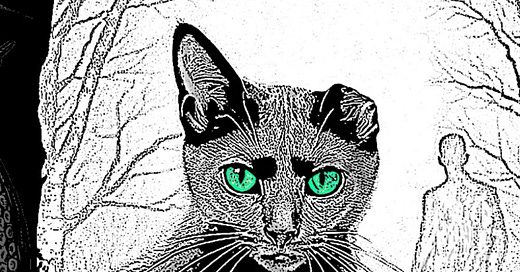The phrase “Lovecraft’s cat” has become a meme, and a viral one at that. Ever since his debut in “The Rats in the Walls” (1924), H.P. Lovecraft’s familiar feline has entered the online lexicon as a playful way to say the unnamable. Well, now, in Anno 2025, Bizarchives stalwart Mr. C.P. Webster (The Horror Beneath) has taken it upon himself to wrestle with the Lovecraft family cat. But this book is no meme, mind you. Webster takes the Anglo-American horror tradition seriously, and Lovecraft’s Cat is an excellent volume replete with tales fit for a frightful night. In this volume, the classic style is revived, as Webster pens stories that recall the golden age of pulp horror, science fiction, and action-adventure.
Of the book’s fourteen stories, four are original to the volume. The first one is the titular tale. “Lovecraft’s Cat” is a sweet, pleasant little yarn involving two ghosts—the ghost of the black cat and the phantom of its gentlemanly owner. Set in Providence and featuring a lonely academic, “Lovecraft’s Cat” is a delightful opening course that pays tribute to the Old Man who inspires us all.
The second original tale, “The Jackals Will Come for Their Own,” is a sequel to another story, “The Pimlico Vampire.” In both, the antagonist is the vile Luke D’Arcy, a malevolent magician who has found the secret to immortality. “The Pimlico Vampire,” which originally appeared in The Bizarchives #5, is set in 1970s London. D’Arcy leaves been mummified corpses prior to causing a historical disaster above London’s gray skies. His escape at the story’s end infuriates the manhunter Jim Padgett. “The Jackals Will Come for Their Own” completes the whole mess, as retired Detective-Inspector Padgett and occult investigator Vernon Smith meet D’Arcy in Egypt, where the latter is dead-set on completing a ritual that harkens back to the resurrection of Osiris.
Speaking of stories from the Bizarchives, this collection features several that first appeared in those eldritch pages. “The Sea Witch” (Bizarchives #7), “The Eyes of Kwenengawa”, and “Beast of Babylon” (both Bizarchives #8) are all perfect examples of Mr. Webster’s ability to innovate within established genres. “The Sea Witch” features a vaguely Lovecraftian entity from the sea, but its distinctive character is closer to the works of M.R. James, albeit James if he were less of a prudish churchman. “The Eyes of Kwenengawa” fits nicely next to “The Four Horsemen,” which is likewise set in South Africa. In both tales, hardy Boers and proud Englishmen do battle against cosmic terrors lurking in the veldt and similar environs. “Beast of Babylon” is arguably Webster’s best piece, as the Weimar era detective tale practically begs for more. Karl von Hallerstein and Gustav Wessel are two characters who demand more attention, and “Beast of Babylon,” what with its invocations of the National Socialists, Crowley, and sex magick, is the definition of must-read short fiction.
If there is any single thread or theme in Lovecraft’s Cat it is the prevalence of hauntings. There are several haunted houses, haunted manuscripts, and haunted minds in this collection. “A Weekend at Uncle Andrew’s,” “The Return of the Prodigal,” and “Still Here” all make use of the ancient haunted house trope. These stories showcase Webster’s knack for creating atmosphere, or rather his skill at capturing the naturally unnerving atmosphere of an English manor house on a foggy afternoon. “Song of Sybarios,” which features ancient pagan rituals from the primordial Aegean world, and “The Duellists,” which is a kind of evil Shangri-La tale set during World War I, prove that Webster is more than capable of writing beyond the haunted house genre.
Lovecraft’s Cat is a lovely little volume that should be mandatory reading for multiple kinds of people. The first group should be the easiest to please. These are the horror lovers—the weirdos, the sickos, the syphilitic tribe that enjoys nothing more than a warm murder on a cold night. Lovecraft’s Cat is meat and potatoes for such readers. There is no postmodernism here, and certainly no Reddit-tier, above-it-all-type nonsense about the “problematic” nature of horror. It’s just damn good horror produced by someone who loves the genre.
The second type of people who should read this book are those who operate under the delusion that nothing worthwhile has been written since 1990. Lovecraft’s Cat is part of a broader renaissance in short fiction penned for and published by indie mags. Men like Webster are keeping an old flame well lit, and they are doing so without the benefit of big payouts or major marketing. Lovecraft’s Cat is art for the sake of art penned by a man otherwise scorned by the chattering classes.
The final type of people who need this volume are the dunderheads who repeat the mantra that “the right can’t make art.” First of all, those who utter such bilge typically have a very strict definition of “art” that is already biased in favor of the Jacobin offspring. Second, Mr. Webster does not hide his political leanings, and a similar statement could be made about all the Bizarchives boys. However, as Lovecraft’s Cat shows, true right-wing art is subtle, rooted in traditions, and accepts a baseline normality in order to pervert it (and such perversion is a bad thing!). In other words, good right-wing art is never explicitly political, and thus tends to fly under the radar for those seeking the right-leaning equivalent to spirit cooking or whatever.
Give ‘em Lovecraft’s Cat, I say, and let the anti-feline bozos learn to love the malicious meows of Webster and co.
4.5 out of 5.




Cheers for the review sir. And if I do say so myself, you are most discerning :)